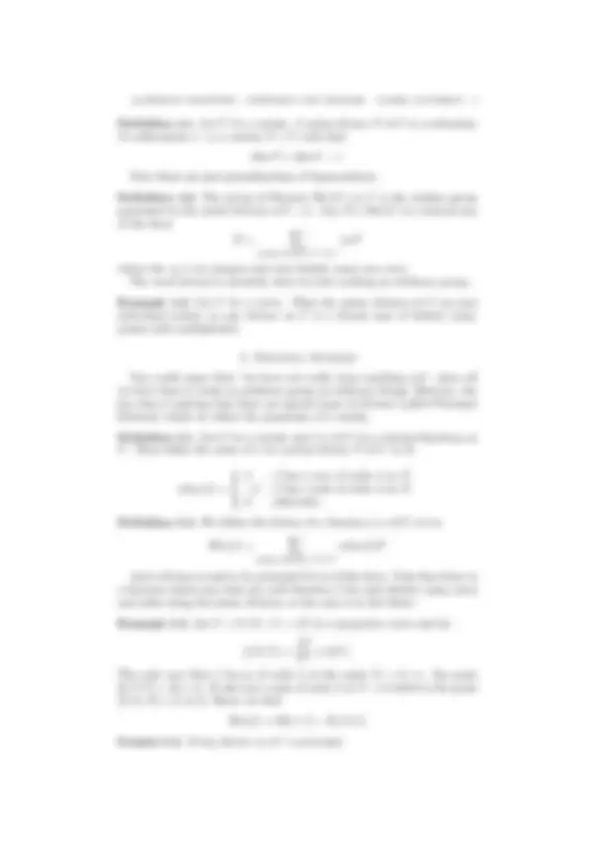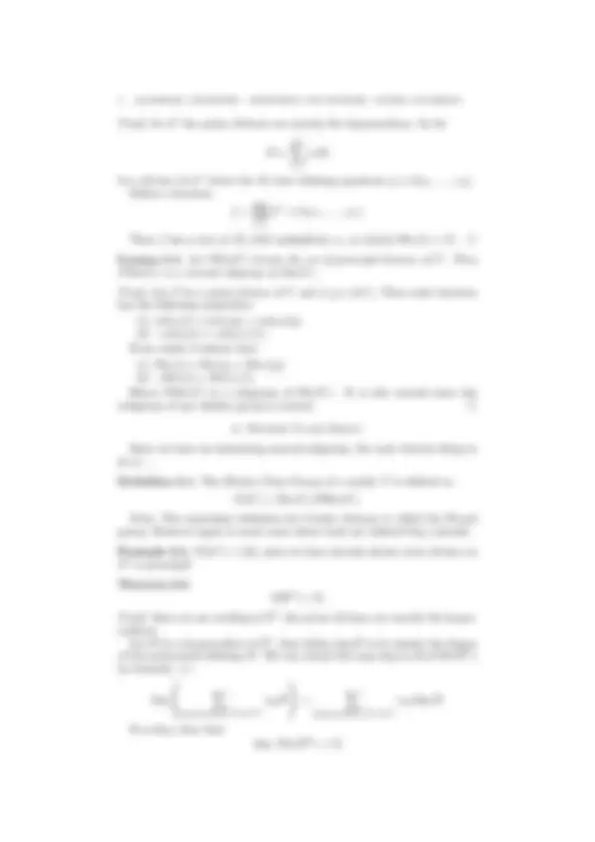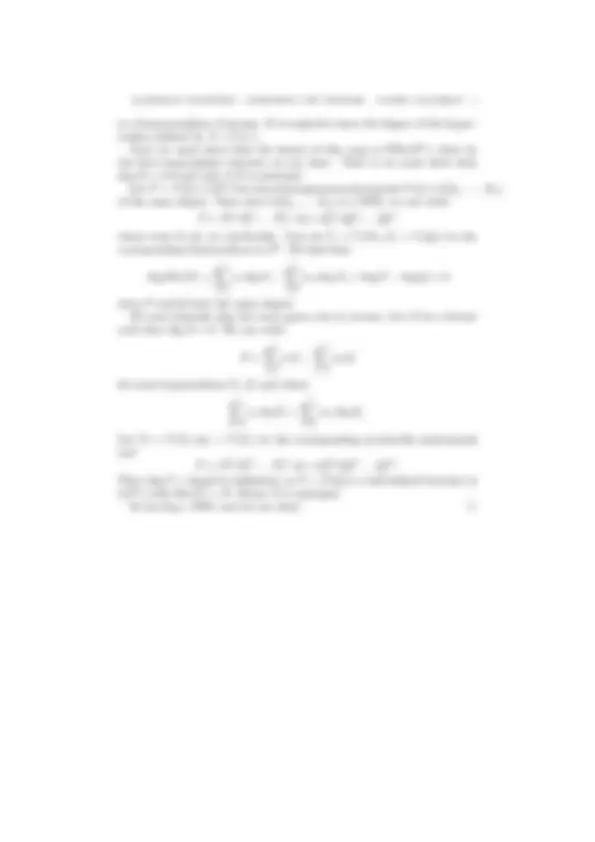





Study with the several resources on Docsity

Earn points by helping other students or get them with a premium plan


Prepare for your exams
Study with the several resources on Docsity

Earn points to download
Earn points by helping other students or get them with a premium plan
Community
Ask the community for help and clear up your study doubts
Discover the best universities in your country according to Docsity users
Free resources
Download our free guides on studying techniques, anxiety management strategies, and thesis advice from Docsity tutors
Introduction Dimension Hypersurfaces Principal Divisors
Typology: Study notes
1 / 5

This page cannot be seen from the preview
Don't miss anything!




Theorem 1.1. Let 푘 be an algebraically closed field (we make this assump- tion throughout the lecture). Then two varieties 푉 and 푊 are birationally equivalent if and only if the function fields 푘(푉 ) and 푘(푊 ) are isomorphic.
Today I will show you another one, namely the dimension of a variety. This will also be useful in enabling us to begin to classify and define certain types of algebraic sets. I shall also define the Divisor class group of a variety which reflects the geometry of the variety, but this is not a birational invariant.
Definition 2.1. Let 퐿 be a field extension of a field 퐾, i.e. 퐾 ⊂ 퐿. Then 퐿 is said to be algebraic over 퐾 if every element of 퐿 is the zero of a polynomial with coefficients in 퐾. Otherwise it is called transcendental.
Example 2.2. ℚ[
2] over ℚ. Note it suffices to only check for the genera- tors of 퐿. In this case, we have
2 is a root of 푥^2 − 2.
Definition 2.3. Let 푉 be a variety with function field 푘(푉 ). The dimension of 푉 is the largest 푚 such that 푘(푉 ) is algebraic over 푘(푦 1 ,... , 푦푚). 1
More technically, the dimension of 푉 to be the transcendence degree of 푘(푉 ) over k.
Example 2.4. (1) dim 픸푛^ = 푛 since the function field is just 푘(푥 1 ,... , 푥푛). (2) The map 휑 : ℙ푛^ → 픸푛^ given by
휑 : [푥 0 , 푥 1 ,... , 푥푛] 7 →
is a birational map defined on the subset of ℙ푛^ with 푥푛 ∕= 0. Hence ℙ푛^ is birational to 픸푛, so their function fields are isomorphic and so dim ℙ푛^ = 푛. (3) Let 푉 = 푉 (푧^2 −푥^3 −푦^3 ) be an affine variety. Then 푘(푉 ) = 푘(푥, 푦, 푧)/(푧^2 − 푥^3 − 푦^3 ). This is basically just the field 푘(푥, 푦, 푧) in which we declare 푧^2 = 푥^3 + 푦^3. So any function in 푘(푉 ) is of the form 푓 (푥, 푦) + 푧푔(푥, 푦) 푝(푥, 푦) + 푧푞(푥, 푦) where 푓, 푔, 푝, 푞 ∈ 푘[푥, 푦]. So you can think of 푘(푉 ) as 푘(푥, 푦) adjoin- ing an element 푧 whose square is inside 푘(푉 ). So 푘(푉 ) is algebraic over 푘(푥, 푦), hence 푉 has dimension 2. (4) An algebraic set of dimension 1 is called a curve and an algebraic set of dimension 2 is called a surface.
This definition of dimension is part of a theme in algebraic geometry, whereby you want to phrase everything in purely algebraic terms. The reasoning behind this is that you want to try to remove coordinate systems. For example any variety 푉 ⊂ ℙ푛^ can be embedded in ℙ푚^ for any 푚 ≥ 푛. But we want to consider each embedded variety as “the same”, so you can see that it makes more sense to define the properties of algebraic sets independently of their particular embedding.
We shall now briefly outline a very special type of algebraic set that often crops up.
Definition 3.1. An algebraic set in 픸푛^ (resp. ℙ푛) of dimension 푛 − 1 is called a hypersurface.
Theorem 3.2. An algebraic set 푉 is a hypersurface in 픸푛^ (resp. ℙ푛) if and only if it can be given as the zero set of a single polynomial 푓 ∈ 푘[푥 1 ,... , 푥푛] (resp. 푓 ∈ 푘[푥 0 ,... , 푥푛] homogeneous). Moreover, 푉 is a variety if and only if 푓 is irreducible.
Proof. (Of the second part). The ideal generated by a single polynomial 푓 is prime if and only if 푓 is irreducible. □
Proof. In 픸푛^ the prime divisors are exactly the hypersurfaces. So let
푖=
be a divisor of 픸푛^ where the 퐻푖 have defining equations 푓푖 ∈ 푘[푥 1 ,... , 푥푛]. Define a function 푓 =
푖=
Then 푓 has a zero at 퐻푖 with multiplicity 푛푖, so clearly Div(푓 ) = 퐷. □
Lemma 5.5. Let PDiv(푉 ) denote the set of principal divisors of 푉. Then PDiv(푉 ) is a normal subgroup of Div(푉 ).
Proof. Let 푃 be a prime divisor of 푉 and 푓, 푔 ∈ 푘(푉 ). Then order function has the following properties:
(1) ord푃 (푓 ) + ord푃 (푔) = ord푃 (푓 푔). (2) −ord푃 (푓 ) = ord푃 (1/푓 ). From which it follows that (1) Div(푓 ) + Div(푔) = Div(푓 푔). (2) −Div(푓 ) = Div(1/푓 ). Hence PDiv(푉 ) is a subgroup of Div(푉 ). It is also normal since the subgroup of any abelian group is normal. □
Since we have an interesting normal subgroup, the next obvious thing to do is...
Definition 6.1. The Divisor Class Group of a variety 푉 is defined as
Cl(푉 ) = Div(푉 )/PDiv(푉 ). Note: The equivalent definition for Cartier divisors is called the Picard group. However again in most cases where both are defined they coincide.
Example 6.2. Cl(픸푛) = { 0 }, since we have already shown every divisor on 픸푛^ is principal!
Theorem 6.3. Cl(ℙ푛) ≃ ℤ.
Proof. Since we are working in ℙ푛, the prime divisors are exactly the hyper- surfaces. Let 퐻 be a hypersurface in ℙ푛, then define deg 퐻 to be simply the degree of the polynomial defining 퐻. We can extend the map deg to all of Div(ℙ푛) by linearity. i.e.
deg
hypersurfaces 퐻 of ℙ푛
hypersurfaces 퐻 of ℙ푛
푛퐻 deg 퐻.
It is then clear that deg : Div(ℙ푛) → ℤ
is a homomorphism of groups. It is surjective since the degree of the hyper- surface defined by 푋 = 0 is 1. Next we must show that the kernel of this map is PDiv(ℙ푛), then by the first isomorphism theorem we are done. That is we must show that deg 퐷 = 0 if and only if 퐷 is principal. Let 퐹 = 푃/푄 ∈ 푘(ℙ푛) for some homogeneous polynomials 푃, 푄 ∈ 푘[푋 0 ,... , 푋푛] of the same degree. Then since 푘[푋 0 ,... , 푋푛] is a UFD, we can write
푃 = 푃 1 푛 1 푃 2 푛 2... 푃 (^) 푠푛 푠, 푄 = 푄푚 1 1 푄푚 2 2... 푄푚 푡푡
where each 푃푖, 푄푖 are irreducible. Now let 푌푖 = 푉 (푃푖), 푍푖 = 푉 (푄푖) be the corresponding hypersurfaces in ℙ푛. We find that
deg Div(퐹 ) =
푖=
푛푖 deg 푌푖 −
푖=
푚푖 deg 푍푖 = deg 푃 − deg 푄 = 0
since 푃 and 푄 have the same degree. We now basically play the same game, but in reverse. Let 퐷 be a divisor such that deg 퐷 = 0. We can write
푖=
푖=
for some hypersurfaces 푌푖, 푍푖 and where
X^ 푠
푖=
푛푖 deg 푌푖 =
푖=
푚푖 deg 푍푖.
Let 푃푖 = 푉 (푌푖), 푄푖 = 푉 (푍푖) be the corresponding irreducible polynomials and 푃 = 푃 1 푛 1 푃 2 푛 2... 푃 (^) 푠푛 푠, 푄 = 푄푚 1 1 푄푚 2 2... 푄푚 푡 푡.
Then deg 푃 = deg 푄 by definition, so 퐹 = 푃/푄 is a well-defined function in 푘(ℙ푛) with Div(퐹 ) = 퐷. Hence 퐷 is principal. So ker deg = PDiv and we are done. □